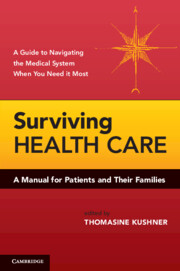Book contents
- Frontmatter
- Contents
- Contributors
- Preface
- 1 Letter to Patients
- 2 Becoming an Active Member of Your Health Care Team
- 3 Information That Will Help You with Advance Planning for Your Health Care
- 4 Responding to Medical Emergencies
- 5 What You Need to Know about Medical Errors
- 6 Being Informed When You Give Consent to Medical Care
- 7 Beware of Scorecards
- 8 Transplantation 101
- 9 When the Illness Is Psychiatric
- 10 On the Horizon
- 11 To Be or Not to Be – A Research Subject
- 12 Information That Will Help You Make Health Care Decisions for Adult Family Members
- 13 Caring for Individuals with Alzheimer's Disease
- 14 When the Patient Is a Child
- 15 Care of Elders
- 16 Being and Thinking
- 17 A Patient's Guide to Pain Management
- 18 The Hardest Decisions
- 19 What You Need to Know about Disasters
- 20 Making the Internet Work for You
- Appendix: Patient Individual Profile
- Index
1 - Letter to Patients
On Becoming the “Good” Patient and Finding the “Right” Doctor
Published online by Cambridge University Press: 05 June 2012
- Frontmatter
- Contents
- Contributors
- Preface
- 1 Letter to Patients
- 2 Becoming an Active Member of Your Health Care Team
- 3 Information That Will Help You with Advance Planning for Your Health Care
- 4 Responding to Medical Emergencies
- 5 What You Need to Know about Medical Errors
- 6 Being Informed When You Give Consent to Medical Care
- 7 Beware of Scorecards
- 8 Transplantation 101
- 9 When the Illness Is Psychiatric
- 10 On the Horizon
- 11 To Be or Not to Be – A Research Subject
- 12 Information That Will Help You Make Health Care Decisions for Adult Family Members
- 13 Caring for Individuals with Alzheimer's Disease
- 14 When the Patient Is a Child
- 15 Care of Elders
- 16 Being and Thinking
- 17 A Patient's Guide to Pain Management
- 18 The Hardest Decisions
- 19 What You Need to Know about Disasters
- 20 Making the Internet Work for You
- Appendix: Patient Individual Profile
- Index
Summary
I'm sorry to learn that you're sick. Your doctor has diagnosed you with an illness, has said it may be serious, and told you that you need treatment. You have become a patient. Being sick is difficult enough; being a patient comes with its own set of challenges.
You ask me (a physician and psychiatrist) what to do, how you can be a good patient, and how to choose the right doctor. You're hoping for a prescription, a set of clear instructions, maybe a checklist. I wish I could provide them, but in all honesty, I can't.
Fifty years ago, I could have told you simply to let your doctor make the decisions, both big and small, and to follow his or her orders. However, our culture and our technology have both changed since then, and with them, our ideas, choices, and practices regarding illness and medicine and doctors and patients have changed as well. No longer do we accept or believe that passive compliance is necessarily the best response (although for any given person and medical situation, it might be). Doctors, too, have come to see their role differently, no longer as parents who know best what's good for their patients and what the right decisions are for their lives.
Twenty years ago, I might also have been able to respond quite easily, although quite differently, as to how you can be a good patient: inform yourself as best you can about your illness and its treatment, and make your own decisions.
Keywords
- Type
- Chapter
- Information
- Surviving Health CareA Manual for Patients and Their Families, pp. 1 - 12Publisher: Cambridge University PressPrint publication year: 2010



